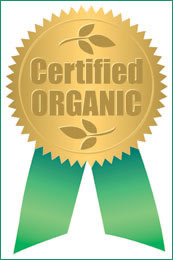NICHE ORGANIC MARKET
Organic potatoes attract industry’s—and scientists’—attention
by MARLENE FRITZ

THEY MAY ONLY BE A HALF-PERCENT of U.S. potato production, but Jeff Bragg, who graduated from the UI with an M.S. in agricultural education in 2003, says organic potatoes are a niche that simply must be addressed.
“There’s quite a movement afoot for organics,” says the Idaho Falls- based director of product develop- ment at Potandon, the nation’s largest potato shipper. “Our customers are clamoring for them.” Interest is heating up on the supply side, too. “Growers hear that the demand is growing, and they’re always looking for a way out of the slump they’ve been in,” Bragg says.
With more organic pest-control products available, even larger producers have begun to try it, Bragg says. “If people realize they can come up with the kinds of crops that we’ve seen, I think demand is going to steadily increase.”
Idaho growers produced 495 acres of organic potatoes in 2007, compared with 313 in 2003, says Margaret Misner, organic program manager for the Idaho State Department of Agriculture.
At Buhl, Mike Heath, growing organic potatoes since the early 1980s, plants about 50 acres and rotates his crop every five to seven years—planting potatoes roughly half as often as conventional producers—to disrupt pest cycles and keep soils healthy.
Heath knows where he’ll sell his potatoes before he ever plants them. He produces his processing potatoes under contract and markets his freshpack potatoes to a reliable shortlist of buyers. He uses an organically approved pesticide on his Colorado potato beetles and manages weeds with additional cultivation and hand weeding as needed.
Prices good; still, proceed with caution
While wholesale prices of conventionally grown russets hovered around $15 to $17 per hundred- weight in Chicago, San Francisco, and Seattle this past January, they soared to about $22 to $28 for organics, says Joe Guenthner, University of Idaho agricultural economist.
At the retail level, the 50 percent premium that organic potatoes command- ed in 2002 doubled to 100 percent by 2007. Still, in spring 2007 felt there was unmet demand for organic potatoes, which prompts Guenthner to give the crop a flashing yellow—rather than a green—light. “It would not take much to flood the market,” he says.
“I’m pretty positive that the demand is there,” says Heath. “The big question for small growers like myself is how many larger growers will be getting into it, and what effect that will that have on the organic market.”
In Rexburg, grower-packer Grant Ricks is having second thoughts. Now in his third year of organic potato production, Ricks says organic customer preferences for medium-sized potatoes over larger ones means he has to kill his vines before tubers get too big.
The result: lower yields and profits, which is making stratospheric grain prices look mighty tempting.
UI launches organic studies
 Pest
management strategic plan: In Boise, University of Idaho pesticide coordinator Ronda Hirnyck and Northwest Coalition for Alternatives to Pesticides program coordinator Jennifer Miller are leading development of a pest-management strategic plan for organic potato production in Idaho. Contributing to this plan— which will identify research, education, and regulatory needs—are growers, industry representatives, and land-grant university scientists. Pest
management strategic plan: In Boise, University of Idaho pesticide coordinator Ronda Hirnyck and Northwest Coalition for Alternatives to Pesticides program coordinator Jennifer Miller are leading development of a pest-management strategic plan for organic potato production in Idaho. Contributing to this plan— which will identify research, education, and regulatory needs—are growers, industry representatives, and land-grant university scientists.
 Dense
planting benefits: After Bryan Hopkins, formerly of the University of Idaho, proved that planting organic potatoes densely in drip-irrigated beds makes weed problems much more manageable, Miller says growers responded by formulating strategies to maximize early vine growth and canopy closure. Dense
planting benefits: After Bryan Hopkins, formerly of the University of Idaho, proved that planting organic potatoes densely in drip-irrigated beds makes weed problems much more manageable, Miller says growers responded by formulating strategies to maximize early vine growth and canopy closure.
 Hand
labor vs. machine cultivation: At Aberdeen, university weed scientist Pamela Hutchinson is seeking additional funding to compare the economics of hand labor with early shading in bed-planted, drip-irrigated organic spuds versus machine cultivation in row-spaced, conventionally irrigated organic potatoes. Hand
labor vs. machine cultivation: At Aberdeen, university weed scientist Pamela Hutchinson is seeking additional funding to compare the economics of hand labor with early shading in bed-planted, drip-irrigated organic spuds versus machine cultivation in row-spaced, conventionally irrigated organic potatoes.
 Organic
cropping system study: UI scientists at Kimberly are launching a long-term study of an organic cropping system, including potatoes. Two emphases: UI Extension potato specialist Nora Olsen will compare potato varieties for their storage performance under organic production, and UI Extension soil specialist Amber Moor will study organic nutrients. Organic
cropping system study: UI scientists at Kimberly are launching a long-term study of an organic cropping system, including potatoes. Two emphases: UI Extension potato specialist Nora Olsen will compare potato varieties for their storage performance under organic production, and UI Extension soil specialist Amber Moor will study organic nutrients.
|